市场营销复习资料
市场营销复习资料
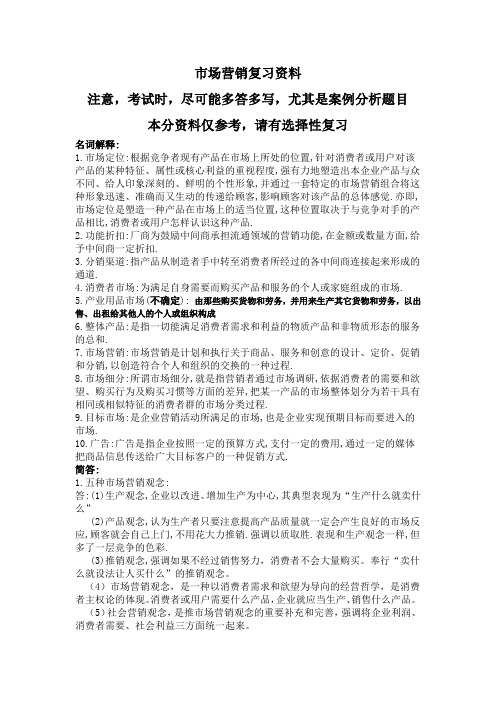
市场营销复习资料注意,考试时,尽可能多答多写,尤其是案例分析题目本分资料仅参考,请有选择性复习名词解释:1.市场定位:根据竞争者现有产品在市场上所处的位置,针对消费者或用户对该产品的某种特征、属性或核心利益的重视程度,强有力地塑造出本企业产品与众不同、给人印象深刻的、鲜明的个性形象,并通过一套特定的市场营销组合将这种形象迅速、准确而又生动的传递给顾客,影响顾客对该产品的总体感觉.亦即,市场定位是塑造一种产品在市场上的适当位置,这种位置取决于与竞争对手的产品相比,消费者或用户怎样认识这种产品.2.功能折扣:厂商为鼓励中间商承担流通领域的营销功能,在金额或数量方面,给予中间商一定折扣.3.分销渠道:指产品从制造者手中转至消费者所经过的各中间商连接起来形成的通道.4.消费者市场:为满足自身需要而购买产品和服务的个人或家庭组成的市场.5.产业用品市场(不确定):由那些购买货物和劳务,并用来生产其它货物和劳务,以出售、出租给其他人的个人或组织构成6.整体产品:是指一切能满足消费者需求和利益的物质产品和非物质形态的服务的总和.7.市场营销:市场营销是计划和执行关于商品、服务和创意的设计、定价、促销和分销,以创造符合个人和组织的交换的一种过程.8.市场细分:所谓市场细分,就是指营销者通过市场调研,依据消费者的需要和欲望、购买行为及购买习惯等方面的差异,把某一产品的市场整体划分为若干具有相同或相似特征的消费者群的市场分类过程.9.目标市场:是企业营销活动所满足的市场,也是企业实现预期目标而要进入的市场.10.广告:广告是指企业按照一定的预算方式,支付一定的费用,通过一定的媒体把商品信息传送给广大目标客户的一种促销方式.简答:1.五种市场营销观念:答:(1)生产观念,企业以改进、增加生产为中心,其典型表现为“生产什么就卖什么”(2)产品观念,认为生产者只要注意提高产品质量就一定会产生良好的市场反应,顾客就会自己上门,不用花大力推销.强调以质取胜.表现和生产观念一样,但多了一层竞争的色彩.(3)推销观念,强调如果不经过销售努力,消费者不会大量购买。
市场营销学复习资料
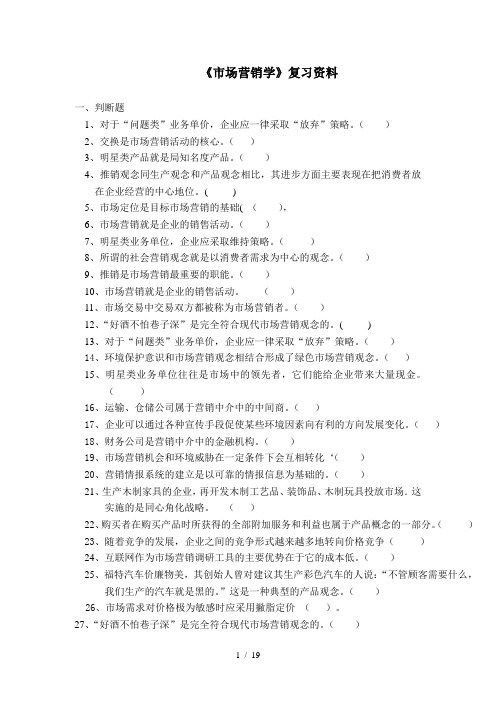
《市场营销学》复习资料一、判断题1、对于“问题类”业务单价,企业应一律采取“放弃”策略。
()2、交换是市场营销活动的核心。
()3、明星类产品就是局知名度产品。
()4、推销观念同生产观念和产品观念相比,其进步方面主要表现在把消费者放在企业经营的中心地位。
( )5、市场定位是目标市场营销的基础( (),6、市场营销就是企业的销售活动。
()7、明星类业务单位,企业应采取维持策略。
()8、所谓的社会营销观念就是以消费者需求为中心的观念。
()9、推销是市场营销最重要的职能。
()10、市场营销就是企业的销售活动。
()11、市场交易中交易双方都被称为市场营销者。
()12、“好酒不怕巷子深”是完全符合现代市场营销观念的。
( )13、对于“问题类”业务单价,企业应一律采取“放弃”策略。
()14、环境保护意识和市场营销观念相结合形成了绿色市场营销观念。
()15、明星类业务单位往往是市场中的领先者,它们能给企业带来大量现金。
()16、运输、仓储公司属于营销中介中的中间商。
()17、企业可以通过各种宣传手段促使某些环境因素向有利的方向发展变化。
()18、财务公司是营销中介中的金融机构。
()19、市场营销机会和环境威胁在一定条件下会互相转化‘()20、营销情报系统的建立是以可靠的情报信息为基础的。
()21、生产木制家具的企业,再开发木制工艺品、装饰品、木制玩具投放市场.这实施的是同心角化战略。
()22、购买者在购买产品时所获得的全部附加服务和利益也属于产品概念的一部分。
()23、随着竞争的发展,企业之间的竞争形式越来越多地转向价格竞争()24、互联网作为市场营销调研工具的主要优势在于它的成本低。
()25、福特汽车价廉物美,其创始人曾对建议其生产彩色汽车的人说:“不管顾客需要什么,我们生产的汽车就是黑的。
”这是一种典型的产品观念。
()26、市场需求对价格极为敏感时应采用撇脂定价()。
27、“好酒不怕巷子深”是完全符合现代市场营销观念的。
《市场营销学》复习资料
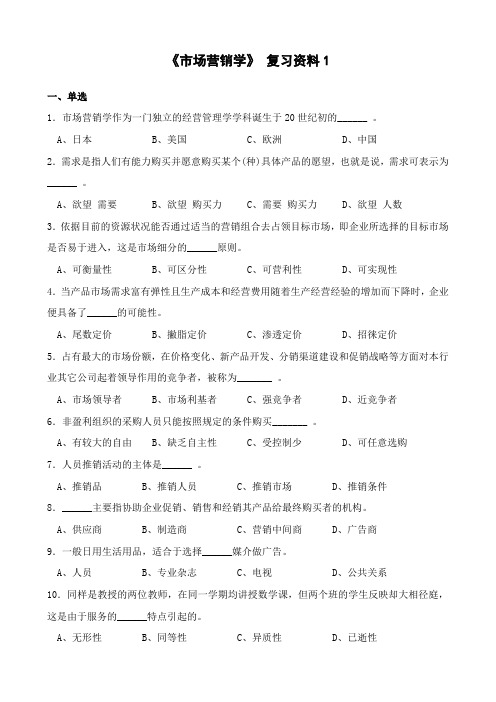
《市场营销学》复习资料1一、单选1.市场营销学作为一门独立的经营管理学学科诞生于20世纪初的______ 。
A、日本B、美国C、欧洲D、中国2.需求是指人们有能力购买并愿意购买某个(种)具体产品的愿望,也就是说,需求可表示为______ 。
A、欲望需要B、欲望购买力C、需要购买力D、欲望人数3.依据目前的资源状况能否通过适当的营销组合去占领目标市场,即企业所选择的目标市场是否易于进入,这是市场细分的______原则。
A、可衡量性B、可区分性C、可营利性D、可实现性4.当产品市场需求富有弹性且生产成本和经营费用随着生产经营经验的增加而下降时,企业便具备了______的可能性。
A、尾数定价B、撇脂定价C、渗透定价D、招徕定价5.占有最大的市场份额,在价格变化、新产品开发、分销渠道建设和促销战略等方面对本行业其它公司起着领导作用的竞争者,被称为_______ 。
A、市场领导者B、市场利基者C、强竞争者D、近竞争者6.非盈利组织的采购人员只能按照规定的条件购买_______ 。
A、有较大的自由B、缺乏自主性C、受控制少D、可任意选购7.人员推销活动的主体是______ 。
A、推销品B、推销人员C、推销市场D、推销条件8.______主要指协助企业促销、销售和经销其产品给最终购买者的机构。
A、供应商B、制造商C、营销中间商D、广告商9.一般日用生活用品,适合于选择______媒介做广告。
A、人员B、专业杂志C、电视D、公共关系10.同样是教授的两位教师,在同一学期均讲授数学课,但两个班的学生反映却大相径庭,这是由于服务的______特点引起的。
A、无形性B、同等性C、异质性D、已逝性。
市场营销学复习资料(单选与答案)
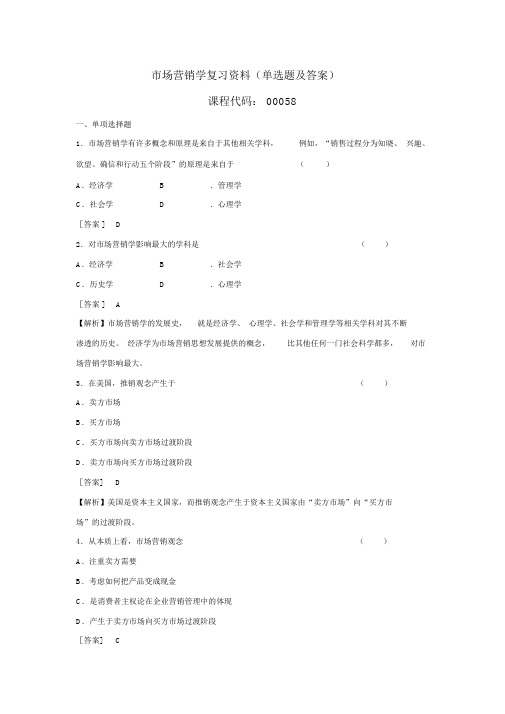
市场营销学复习资料(单选题及答案)课程代码: 00058一、单项选择题1.市场营销学有许多概念和原理是来自于其他相关学科,例如,“销售过程分为知晓、兴趣、欲望、确信和行动五个阶段”的原理是来自于()A.经济学B.管理学C.社会学D.心理学[答案 ]D2.对市场营销学影响最大的学科是()A.经济学B.社会学C.历史学D.心理学[答案 ]A【解析】市场营销学的发展史,就是经济学、心理学、社会学和管理学等相关学科对其不断渗透的历史。
经济学为市场营销思想发展提供的概念,比其他任何一门社会科学都多,对市场营销学影响最大。
3.在美国,推销观念产生于()A.卖方市场B.买方市场C.买方市场向卖方市场过渡阶段D.卖方市场向买方市场过渡阶段[答案] D【解析】美国是资本主义国家,而推销观念产生于资本主义国家由“卖方市场”向“买方市场”的过渡阶段。
4.从本质上看,市场营销观念()A.注重卖方需要B.考虑如何把产品变成现金C.是消费者主权论在企业营销管理中的体现D.产生于卖方市场向买方市场过渡阶段[答案] C【解析】从本质上说,市场营销观念是一种以顾客需要和欲望为导向的哲学,是消费者主权论在企业管理中的体现。
5.边际学派经济学家提出被用于解释消费者行为的概念是()A.欲望B.动机C.效用D.恩格尔定律[答案] C6.运用政治力量和公共关系打破国际或国内市场上的贸易壁垒,为企业的市场营销开辟道路。
这种新的战略思想被称为()A.大量市场营销B.产品差异市场营销C.目标市场营销D.大市场营销[答案]D7.瘦狗类战略业务单位的特征是()A.高市场增长率和低相对市场占有率B.高市场增长率和高相对市场占有率C.低市场增长率和高相对市场占有率D.低市场增长率和低相对市场占有率[答案]D8.企业对问号类战略业务单位应采取的战略是()A.发展B.保持C.收制D.放弃[答案]A9.某牙刷生产厂决定增加牙膏生产,这种多元化属于()A.同心多元化B.水平多元化C.集团多元化D.垂直多元化[答案]B10.企业通过增加花色、品种、规格、型号等,向现有市场提供新产品或改进产品,这种增长战略叫做()A.市场渗透B.产品开发C.市场开发D.市场撇取11.在定量研究的各种尺度中,可以进行加减乘除运算的尺度是()A.间距尺度B.名义尺度C.顺序尺度D.比例尺度[答案 ]D【解析】比例尺度的意义是绝对的,比例尺度测定值的差和比都是可以比较的。
市场营销学复习资料
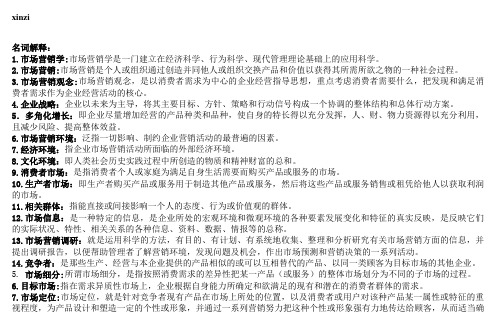
xinzi名词解释:1.市场营销学:市场营销学是一门建立在经济科学、行为科学、现代管理理论基础上的应用科学。
2.市场营销:市场营销是个人或组织通过创造并同他人或组织交换产品和价值以获得其所需所欲之物的一种社会过程。
3.市场营销观念:市场营销观念,是以消费者需求为中心的企业经营指导思想,重点考虑消费者需要什么,把发现和满足消费者需求作为企业经营活动的核心。
4.企业战略:企业以未来为主导,将其主要目标、方针、策略和行动信号构成一个协调的整体结构和总体行动方案。
5.多角化增长:即企业尽量增加经营的产品种类和品种,使自身的特长得以充分发挥,人、财、物力资源得以充分利用,且减少风险、提高整体效益。
6.市场营销环境:泛指一切影响、制约企业营销活动的最普遍的因素。
7.经济环境:指企业市场营销活动所面临的外部经济环境。
8.文化环境:即人类社会历史实践过程中所创造的物质和精神财富的总和。
9.消费者市场:是指消费者个人或家庭为满足自身生活需要而购买产品或服务的市场。
10.生产者市场:即生产者购买产品或服务用于制造其他产品或服务,然后将这些产品或服务销售或租凭给他人以获取利润的市场。
11.相关群体:指能直接或间接影响一个人的态度、行为或价值观的群体。
12.市场信息:是一种特定的信息,是企业所处的宏观环境和微观环境的各种要素发展变化和特征的真实反映,是反映它们的实际状况、特性、相关关系的各种信息、资料、数据、情报等的总称。
13.市场营销调研:就是运用科学的方法,有目的、有计划、有系统地收集、整理和分析研究有关市场营销方面的信息,并提出调研报告,以便帮助管理者了解营销环境,发现问题及机会,作出市场预测和营销决策的一系列活动。
14.竞争者:是那些生产、经营与本企业提供的产品相似的或可以互相替代的产品、以同一类顾客为目标市场的其他企业。
5.市场细分:所谓市场细分,是指按照消费需求的差异性把某一产品(或服务)的整体市场划分为不同的子市场的过程。
市场营销学复习资料

市场营销学复习资料市场营销复习大纲1.市场营销学(菲利普.科特勒)及其核心功能市场营销的定义:市场营销是个人或集体通过创造,提供出售,并同别人交换产品和价值,以获得其所需之物的社会和管理过程△市场营销的核心功能是交换2.需要、欲望和需求?它们之间的区别△人类各种需要和欲望是市场营销的出发点需要:没有得到某些基本满足的感受状态。
(没有指向性的满足欲)欲望:对需要的具体满足物的愿望(当一种指向明确,需要就变成了欲望)需求:对有能力购买并且愿意购买的某个具体产品的欲望。
(当有购买能力时,欲望变转化为需求)3.市场营销学中市场人群+购买力+购买欲望4.市场营销环境的分类;各大类别包含的因素1.市场营销环境的含义:是指与企业市场营销活动相关的所有内外部因素和条件。
2.营销环境的分类:微观营销环境:与企业关系密切、能够直接影响企业服务的各种因素。
(包括企业、供应商、竞争者、营销中介、消费者、公众、信息)宏观营销环境:与企业不存在直接的经济联系,是通过微观营销环境的相关因素作用于企业的较大的社会性因素。
(包括自然生态环境、人口环境、经济环境、政治法律环境、社会文化环境、科技环境) △二者关系:是包容和从属的关系,微观受宏观营销环境的大背景所制约,宏观借助微观营销环境发挥作用。
△营销环境的特征: 客观性不可控性动态性复杂性5.区分个人收入、可支配的个人、可自由支配的个人收入个人收入(personal Income)可支配的个人收入:PI-所得税-非商业开支可自由支配的个人收入:DPI-储蓄-生活用品固定开支6.SWOT分析及用途SWOT:将企业内部与外部环境中有利与不利的方面放在同一个框架中进行分析,以综合评价企业从事事业行业的可行性及风险Strengths优势 Weakness劣势 Opportunity机会 Threat威胁用途:它是一种应用广泛的分析工具,在战略管理,市场营销等学科中经常使用。
7.地球资源的三大种类(举例)地球资源可分为三类,即无限资源、有限可再生资源及有限不可再生资源。
市场营销学复习资料
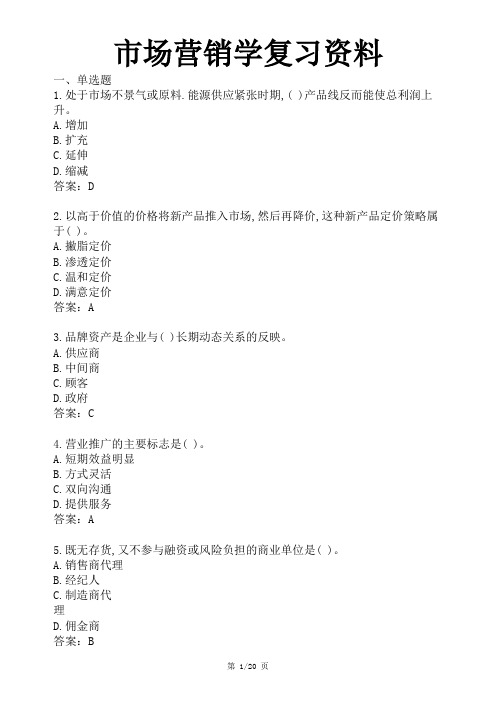
市场营销学复习资料一、单选题1.处于市场不景气或原料.能源供应紧张时期,( )产品线反而能使总利润上升。
A.增加B.扩充C.延伸D.缩减答案:D2.以高于价值的价格将新产品推入市场,然后再降价,这种新产品定价策略属于( )。
A.撇脂定价B.渗透定价C.温和定价D.满意定价答案:A3.品牌资产是企业与( )长期动态关系的反映。
A.供应商B.中间商C.顾客D.政府答案:C4.营业推广的主要标志是( )。
A.短期效益明显B.方式灵活C.双向沟通D.提供服务答案:A5.既无存货,又不参与融资或风险负担的商业单位是( )。
A.销售商代理B.经纪人C.制造商代理D.佣金商答案:B6.在应用( )时,必须注意市场需求的具体特点.消费者的购买能力和产品本身的关联程度大小。
A.更新包装策略B.附赠品包装策略C.配套包装策略D.再使用包装策略答案:C7.成长期营销人员的促销策略主要目标是在消费者心目中建立( )争取新的顾客。
A.品牌偏好B.产品质量C.产品信誉D.产品外观答案:A8.企业要制定正确的竞争战略和策略,就应深入地了解( )。
A.技术创新B.消费需求C.竞争者D.自己的特长答案:C9.市场领导者保护其市场份额的途径是( )。
A.增加使用量B.以攻为守C.转变未使用者D.寻找新用途答案:B10.企业根据市场需求不断开发出适销对路的新产品,以赢得市场竞争的胜利,这是属于( )。
A.速度制胜B.技术制胜C.创新制胜D.优质制胜答案:C11.市场细分化是根据( )的差异对市场进行的划分。
A.产品B.卖方C.买方D.中间商答案:C12.采用( )的模式的企业应具有较强的资源和营销实力。
A.市场集中化B.市场专业化C.产品专业化D.市场的全面覆盖答案:D13.依据目前的资源状况能否通过适当的营销组合去占领目标市场,即企业所选择的目标市场是否易于进入,这是市场细分的( )原则。
A.可衡量性B.可实现性C.可赢利性D.可区分性答案:B14.某种相关群体的有影响力的人物称为( )。
市场营销学复习资料

市场营销学复习资料一、单项选择题1、样品、赠品、优待券这些营业推广工具都属于()A消费者促销工具 B中间商促销工具 C销售员促销工具 D公众促销工具2、适于选择免费样品方式的商品是()A个性化强的商品 B富于选择性、多样化得商品C处于成熟期或旧有品牌的商品 D经常性购买商品3、企业邀请记者参观考察企业,记者撰写了一篇报道企业的文章刊登在报纸上,这种活动叫做() A人员推销 B广告 C公共关系 D营业推广4、通常产品销售增长速度最快的时期是产品生命周期中的()A投入期 B成长期 C成熟期 D衰退期5、按照流转环节或层次的多少,分销渠道可分为()A 直接渠道和间接渠道B 长渠道和短渠道C 宽渠道和窄渠道D 单渠道和多渠道6、如果某公司建立的一级销售渠道属于宽渠道,一定是因为()A 存在多个生产厂家B 存在多个批发商C 存在多个零售商D 存在多个消费者7、()即厂商依据各类中间商在市场营销中所负担的不同职能,给予不同价格折扣。
其目的在于利用价格折扣刺激各类中间商更充分地发挥各自组织市场营销活动的功能。
A 数量折扣B 交易折扣C 季节折扣 D折让8、()是通过减低几中消费者熟知产品的价格,来诱导消费者产生此处价格低廉的心理,以促进消费者购买其他产品,带来总利润的增加。
A整数定价 B 尾数定价 C 声望定价 D招徕定价9、企业利用自己已经成功的产品品牌来推出改良产品或新产品,称之为()A统一品牌策略 B个别品牌策略 C品牌延伸策略 D多品牌策略10、进入成长期的产品普及率一般处在()A 15%以下B 15%--50%C 50%--80% D超过80%11、企业运用各种沟通方式、手段,向消费者传递商品或服务与企业信息,实现双向沟通,使消费者对企业及其产品或服务产生兴趣、好感与信任,进而作出购买决策的活动称为()A 产品策略B 价格策略C 分销策略D 促销策略12、商品经过()环节之后,进入了消费环节。
A生产环节 B 流通环节 C 研发环节 D试产环节13、“向特定顾客群,提供多种产品”是()目标市场选择模式。
市场营销复习资料
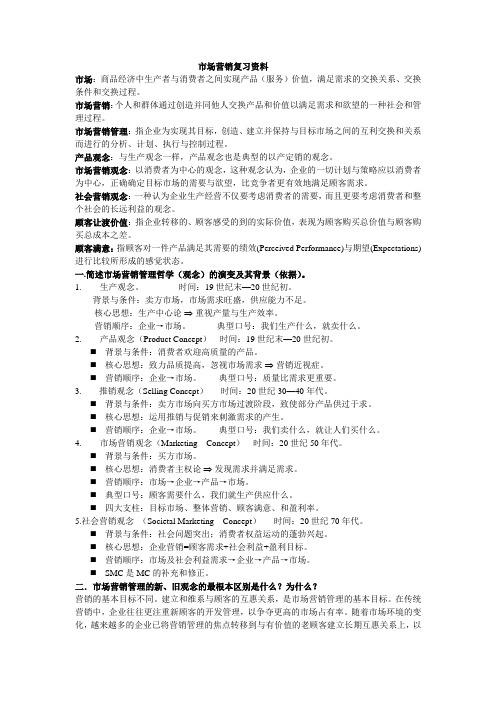
市场营销复习资料市场:商品经济中生产者与消费者之间实现产品(服务)价值,满足需求的交换关系、交换条件和交换过程。
市场营销:个人和群体通过创造并同他人交换产品和价值以满足需求和欲望的一种社会和管理过程。
市场营销管理:指企业为实现其目标,创造、建立并保持与目标市场之间的互利交换和关系而进行的分析、计划、执行与控制过程。
产品观念:与生产观念一样,产品观念也是典型的以产定销的观念。
市场营销观念:以消费者为中心的观念,这种观念认为,企业的一切计划与策略应以消费者为中心,正确确定目标市场的需要与欲望,比竞争者更有效地满足顾客需求。
社会营销观念:一种认为企业生产经营不仅要考虑消费者的需要,而且更要考虑消费者和整个社会的长远利益的观念。
顾客让渡价值:指企业转移的、顾客感受的到的实际价值,表现为顾客购买总价值与顾客购买总成本之差。
顾客满意:指顾客对一件产品满足其需要的绩效(Perceived Performance)与期望(Expectations)进行比较所形成的感觉状态。
一.简述市场营销管理哲学(观念)的演变及其背景(依据)。
1.生产观念。
时间:19世纪末—20世纪初。
背景与条件:卖方市场,市场需求旺盛,供应能力不足。
核心思想:生产中心论⇒重视产量与生产效率。
营销顺序:企业→市场。
典型口号:我们生产什么,就卖什么。
2.产品观念(Product Concept)时间:19世纪末—20世纪初。
⏹背景与条件:消费者欢迎高质量的产品。
⏹核心思想:致力品质提高,忽视市场需求⇒营销近视症。
⏹营销顺序:企业→市场。
典型口号:质量比需求更重要。
3. 推销观念(Selling Concept)时间:20世纪30—40年代。
⏹背景与条件:卖方市场向买方市场过渡阶段,致使部分产品供过于求。
⏹核心思想:运用推销与促销来刺激需求的产生。
⏹营销顺序:企业→市场。
典型口号:我们卖什么,就让人们买什么。
4.市场营销观念(Marketing Concept)时间:20世纪50年代。
市场营销学复习资料(单选及答案)
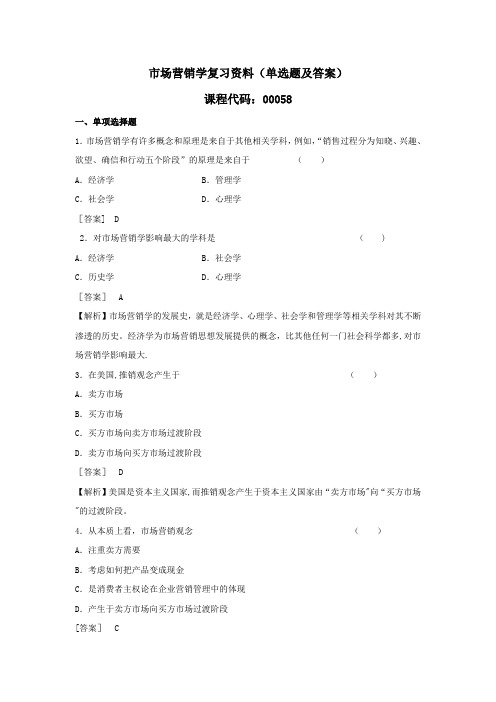
市场营销学复习资料(单选题及答案)课程代码:00058一、单项选择题1.市场营销学有许多概念和原理是来自于其他相关学科,例如,“销售过程分为知晓、兴趣、欲望、确信和行动五个阶段”的原理是来自于()A.经济学 B.管理学C.社会学 D.心理学[答案] D2.对市场营销学影响最大的学科是( )A.经济学 B.社会学C.历史学 D.心理学[答案] A【解析】市场营销学的发展史,就是经济学、心理学、社会学和管理学等相关学科对其不断渗透的历史。
经济学为市场营销思想发展提供的概念,比其他任何一门社会科学都多,对市场营销学影响最大.3.在美国,推销观念产生于()A.卖方市场B.买方市场C.买方市场向卖方市场过渡阶段D.卖方市场向买方市场过渡阶段[答案] D【解析】美国是资本主义国家,而推销观念产生于资本主义国家由“卖方市场"向“买方市场"的过渡阶段。
4.从本质上看,市场营销观念()A.注重卖方需要B.考虑如何把产品变成现金C.是消费者主权论在企业营销管理中的体现D.产生于卖方市场向买方市场过渡阶段[答案] C【解析】从本质上说,市场营销观念是一种以顾客需要和欲望为导向的哲学,是消费者主权论在企业管理中的体现。
5.边际学派经济学家提出被用于解释消费者行为的概念是 ( )A.欲望 B.动机C.效用 D.恩格尔定律[答案] C6.运用政治力量和公共关系打破国际或国内市场上的贸易壁垒,为企业的市场营销开辟道路。
这种新的战略思想被称为()A.大量市场营销 B.产品差异市场营销C.目标市场营销 D.大市场营销[答案] D7.瘦狗类战略业务单位的特征是()A.高市场增长率和低相对市场占有率B.高市场增长率和高相对市场占有率C.低市场增长率和高相对市场占有率D.低市场增长率和低相对市场占有率[答案] D8.企业对问号类战略业务单位应采取的战略是()A.发展 B.保持C.收制 D.放弃[答案] A9.某牙刷生产厂决定增加牙膏生产,这种多元化属于()A.同心多元化 B.水平多元化C.集团多元化 D.垂直多元化[答案] B10.企业通过增加花色、品种、规格、型号等,向现有市场提供新产品或改进产品,这种增长战略叫做 ( )A.市场渗透 B.产品开发C.市场开发 D.市场撇取[答案] B11.在定量研究的各种尺度中,可以进行加减乘除运算的尺度是()A.间距尺度 B.名义尺度C.顺序尺度 D.比例尺度[答案] D【解析】比例尺度的意义是绝对的,比例尺度测定值的差和比都是可以比较的.比例尺度可以进行加减乘除运算。
市场营销学课程复习资料(1406)
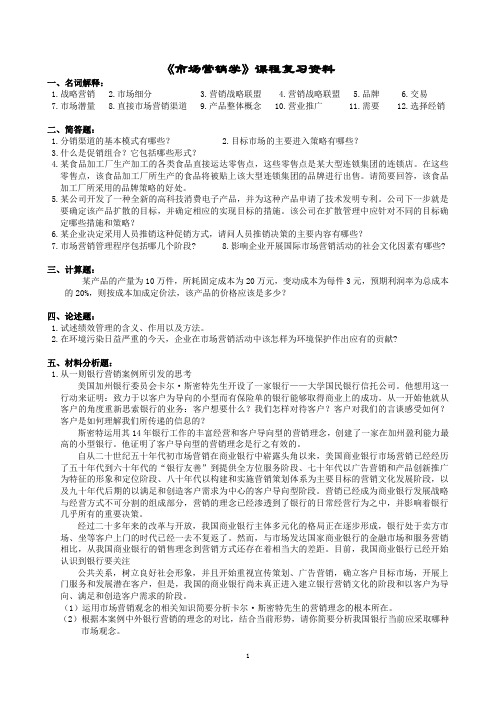
《市场营销学》课程复习资料一、名词解释:1.战略营销2.市场细分3.营销战略联盟4.营销战略联盟5.品牌6.交易7.市场潜量 8.直接市场营销渠道 9.产品整体概念 10.营业推广 11.需要 12.选择经销二、简答题:1.分销渠道的基本模式有哪些?2.目标市场的主要进入策略有哪些?3.什么是促销组合?它包括哪些形式?4.某食品加工厂生产加工的各类食品直接运达零售点,这些零售点是某大型连锁集团的连锁店。
在这些零售点,该食品加工厂所生产的食品将被贴上该大型连锁集团的品牌进行出售。
请简要回答,该食品加工厂所采用的品牌策略的好处。
5.某公司开发了一种全新的高科技消费电子产品,并为这种产品申请了技术发明专利。
公司下一步就是要确定该产品扩散的目标,并确定相应的实现目标的措施。
该公司在扩散管理中应针对不同的目标确定哪些措施和策略?6.某企业决定采用人员推销这种促销方式,请问人员推销决策的主要内容有哪些?7.市场营销管理程序包括哪几个阶段? 8.影响企业开展国际市场营销活动的社会文化因素有哪些?三、计算题:某产品的产量为10万件,所耗固定成本为20万元,变动成本为每件3元,预期利润率为总成本的20%,则按成本加成定价法,该产品的价格应该是多少?四、论述题:1.试述绩效管理的含义、作用以及方法。
2.在环境污染日益严重的今天,企业在市场营销活动中该怎样为环境保护作出应有的贡献?五、材料分析题:1.从一则银行营销案例所引发的思考美国加州银行委员会卡尔·斯密特先生开设了一家银行——大学国民银行信托公司。
他想用这一行动来证明:致力于以客户为导向的小型而有保险单的银行能够取得商业上的成功。
从一开始他就从客户的角度重新思索银行的业务:客户想要什么?我们怎样对待客户?客户对我们的言谈感受如何?客户是如何理解我们所传递的信息的?斯密特运用其14年银行工作的丰富经营和客户导向型的营销理念,创建了一家在加州盈利能力最高的小型银行。
市场营销期末复习资料

市场营销期末复习资料一、名词解释1.市场:现实的和潜在的购买者..2.消费者市场:为满足个人或家庭生活需要而购买商品或劳务的市场..3.市场营销观念:企业从事市场营销活动的基本指导思想或经营哲学..4.市场机会:市场上存在的未被满足的消费需求..5.市场营销环境:与企业营销活动有潜在关系的所有外部力量和相关因素的集合;它是影响企业生存和发展的各种外部条件..宏观环境:社会文化环境、经济环境、政治法律环境、科学技术环境、物质自然环境和金融环境等..微观环境:企业的供货商、营销中介机构、顾客、竞争对手、社会公众以及企业内部参与营销决策的各部门组成..6.国际市场营销调研:运用科学方法;有目的、有计划地搜集、整理和分析有关国际市场营销环境的各种情报、信息和资料;把握市场现状和发展趋势;为营销计划的制定和企业决策提供正确依据的信息管理活动..7.二手资料调研:查询并研究与调研项目有关资料的过程;这些资料是经他人收集、整理和统计过的企业内外的现成信息;又称间接调查法.. 8.实地调研:由调研人员亲自搜集第一手原始资料的过程;又称直接调查法..9.消费者行为:消费者为获取、使用、处置消费品或服务所采取的各种行动;包括先于且决定这些行动的决策过程..10.“经济人”模式:“经济人”的决策行为追求合理和理智;购买者购买决策的作出是建立在一大堆理性的而且清醒的经济计算的基础上的.. 11.市场细分:通过调查分析顾客的不同需求和欲望;企业依据某种标准将顾客划分为若干个顾客群..12.目标市场:企业所确定的作为自己经营对象的有某些特定需要的顾客;也可以说是企业的服务对象或企业产品的销售市场..13.目标营销:企业在市场细分的基础上;选择一个或若干个子市场作为目标市场;并制定相应的营销策略的过程..14.市场的结构吸引力:某一市场内的经营者的数量与质量、市场的进入与退出限制、产品的性质以及市场外的产品销售与生产供应状况等因素所组成的市场结构对其盈利能力的影响与威胁程度..15.无差异性营销策略:企业把一类产品的整体市场看作一个大的目标市场;用一种标准化的营销组合策略;努力吸引更多顾客..16.差异性营销策略:企业把一类产品的整体市场细分为若干个子市场;从中选择多数甚至全部子市场作为自己的目标市场;并为每个目标市场制定不同的市场营销组合方案..17.集中性营销策略:在细分后的市场上;选择两个或少数几个细分市场作为目标市场;实行专业化生产和销售;在个别少数市场上发挥优势;提高市场占有率..18.市场定位:确立企业及产品的整体形象在目标市场上或者说在目标顾客心目中的位置的过程..19.竞争定位法:在现有竞争者某品种的同一位置或附近确定本企业产品的市场位置;努力争取占领市场与扩大销售额..20.产品:能够给购买者带来任何有形和无形利益的载体;是能够满足购买者需求与欲望的物体与服务..21.品牌:产品的名称、标志、符号或设计;用以识别一个或一些销售者的产品或服务;避免与竞争者所提供的产品或服务发生混淆..产品品牌由品牌名称和品牌标志两部分组成..22.商标:是一个具有法律意义的名词;是产品品牌和品牌标志在政府有关部门登记注册之后;获得专用权而受到法律保护的品牌或品牌的一部分;通常被称之为注册商标..23.个性品牌:又称多种品牌;是指企业对不同的产品分别使用不同的品牌;以不同的品牌显示产品的不同特色和档次..24.家族品牌:又称为统一品牌;是指企业对各种产品都使用统一品牌..25.水货:未经制造商授权;却经由特殊营销通路进口而来的产品..水货市场又称为灰色市场或平行输入市场..26.新产品:能够给顾客带来某种新的满足、新的利益的产品..27.个人可支配收入:在个人收入中扣除税款和非税性负担后所得余额;它是个人收入中可以用于消费支出或储蓄的部分;它构成实际的购买力..28.个人可任意支配收入:在个人可支配收入中减去用于维持个人与家庭生存不可缺少的费用如房租、水电、食物、燃料、衣着等项开支后剩余的部分..这部分收入是消费需求变化中最活跃的因素;也是企业开展营销活动时所要考虑的主要对象..29. 参考群体:那些直接面对面或间接影响于人的看法和行为的群体;它可以分为成员群体和非成员群体两种基本类型..二、简答题1.消费品分类..P3-41便利品..便利品又被称作易耗品或日用品;是消费者经常消耗、需要随时购买、价格低廉、购买时不需作太多选择的商品..如面包、饮料及各种农产品等..在促销策略上;广告更重要;销售推广次之..2选购品..选购品是指单价高而且较少购买的商品;消费者更需要深思熟虑以后才会选购这些商品..如房屋、空调、汽车等..在促销策略上;经由中间商进行人员推销更重要;广告次之..3特殊品..特殊品是消费者对其有特殊偏好的商品..这类商品大多价格昂贵;但消费者认为它们能够为自己带来特别的利益;还有一些商品是由于资源有限而成为特殊品..如古董、名贵字画等..2.市场营销观念的发展演变..本题涵盖知识点较多;如果是简答题可以根据题目要求简单回答;具体情况自己酌情处理P9-12在商品经济的发展过程中;市场营销观念也不断地发生变化;其中最重要的变化是从“以产定销”到“以销定产”的转变..1)生产观念..在这种营销观念的指导下;企业的经营重点是努力提高生产效率;增加产量;降低成本;生产出让消费者买得到且买得起的产品;这种观念也称为“生产中心论”..2)产品观念..该观念认为;顾客喜欢质量优、性能好和有特色的产品;因此企业应持续地改进产品质量;不断制造出好的产品;“酒香不怕巷子深”可以形象说明这种观念..但会造成“营销近视症”、“闭门造车”问题.. 3)推销观念..该观念认为;顾客不会主动购买企业的产品;而是要通过卖方的销售刺激;才会被诱导着采取购买行动;因此企业只要对已经生产出来的产品进行大力推销;就能增加销量;获得利润..但这种观念并没有摆脱“以生产为中心”的“以产定销”的范畴..4)市场营销观念..这是买方市场条件下以消费者为中心的营销观念..该观念认为;实现企业目标的关键是切实掌握目标消费者的需要和愿望;并以消费者需求为中心集中企业的一切资源和力量;设计、生产适销对路的产品;安排适当的市场营销组合;采取比竞争者更有效的策略来满足消费者的需求;取得利润..该观念有三个基本要求:①以客户需求为中心;努力满足客户需求..②进行整体营销活动;即综合运用产品、价格、渠道、促销4P等营销因素;同时使企业的营销、生产、财务、人事等部门协调一致;共同满足客户要求..③从长远看;通过满足客户需求来实现利润;是企业的最终目标..营销观念的产生代表着企业经营思想的一次根本性变革..5)社会市场营销观念..该观念认为;企业不是孤立存在的;其生产和销售活动不仅对其客户产生影响;而且必然对广大社会产生一定的影响;因此;企业在从事生产和销售活动时;必须对包括其客户在内的广大社会采取负责的态度;企业在满足顾客需求的同时;应兼顾整个社会的利益;从而实现社会、顾客和社会三者利益的和谐发展..3.为什么说大市场营销观念发展了市场营销观念和社会市场营销观念或者说其三个表现P131在企业与外部关系上;突破了被动适应观点;认为企业不仅可以通过自身的努力来影响;而且可以控制和改变某些外部因素;使之向有利于自己的方向转化..2在企业与市场和目标顾客的关系上;突破了过去那种简单发现、单纯适应与满足的做法;认为应该打开产品通道;积极引导市场和消费;创造目标顾客需要..3在市场营销手段和策略上;在原有的市场营销组合中;又加进了政治手段和公共关系两种重要手段;从而更好地保证了市场营销活动的有效性.. 4.什么是生态学营销观念在这种观念下企业应如何应对P141企业必须充分利用自己的优势;生产那些既是消费者需要又是自己擅长的产品..2企业在制定营销策略时;一定要冷静分析;理性思考;不能只是片面追求满足顾客需求;而要扬长避短;保持与其生存环境的协调平衡关系..5.如何发现市场机会P161可以在现有市场上挖掘潜力;指导现有的产品进一步渗透到现有的目标市场上去;扩大销售量..2可以在现有的产品无潜力可挖的情况下;以现有的产品开发新的市场.. 3在市场开发无潜力可挖时;考虑进行新产品开发..4当产品开发已潜力不大时;可根据自身资源条件考虑多角化经营;在多种经营中寻求新的市场机会..6.营销管理的具体过程P16-171分析市场机会2发掘市场机会3评估市场机会..要使市场机会变成企业的机会;必须与企业的目标相一致..同时企业还必须具有利用该市场机会的能力..4选择目标市场..选择目标市场又分为四个步骤:①市场需要衡量与预测;②市场细分;③选择目标市场;④市场定位5制定市场营销组合7.如何处理企业与市场营销环境的关系P231企业营销活动必须首先适应环境①企业营销必须符合现有的营销环境..②企业要善于从环境中寻找营销机会..存在于环境中的市场机会有潜在的市场机会和边缘的市场机会两种..③企业要根据环境的变化调整营销策略..2企业在开展营销活动时必须发挥主观能动性;设法影响并改变环境..营销管理者的任务不但在于适当安排营销组合;使之与外部不断变化的营销环境相适应;而且要积极创造性地适应和改变环境;创造或改变目标顾客的需要..8.简述国家经济发展的六个阶段..P291传统社会..2起飞准备阶段..3起飞阶段..起飞阶段的必要条件是:①净投资在国民收入中的比例由5%上升到10%以上;②必需有相应的社会、政治体制和结构相配合;③对工业制成品的进口逐渐限制、减少..4趋于成熟阶段..5高度消费阶段..6追求生活质量阶段..9.影响市场规模大小的因素..P30-321人口..包括人口总量、增长率、分布、年龄和性别结构、家庭结构等.. 2收入..衡量一国收入状况的主要指标有:①国民生产总值..它是衡量一个国家经济实力与购买力的重要指标..②人均国民收入..③个人可支配收入..这是在个人收入中扣除税款和非税性负担后所得余额;它是个人收入中可以用于消费支出或储蓄的部分;它构成实际的购买力..④个人可任意支配收入..这是在个人可支配收入中减去用于维持个人与家庭生存不可缺少的费用如房租、水电、食物、燃料、衣着等项开支后剩余的部分..这部分收入是消费需求变化中最活跃的因素;也是企业开展营销活动时所要考虑的主要对象..⑤家庭收入..注:在测定市场潜力时要考虑国民收入和个人收入两个指标;一般来说;用人均收入来衡量日用品的市场潜力;用国民生产总值来衡量工业品的市场潜力..10.供应商对企业营销活动的影响..或说成其影响的表现P361供货的稳定性与及时性2供货的价格变动3供货的质量水平..企业在寻找和选择供应商时;应注意两点:①企业必须充分考虑供应商的资信状况;②企业必须使自己的供货商多样化..11.国际营销调研的内容..P46-471市场机会调研2市场环境调研3市场需求调研..包括市场需求容量、顾客和消费行为调研..4市场供给调研5市场行情调研6市场销售调研..主要包括对销售渠道、销售过程和销售趋势的调研.. 12.请简述国际市场营销调研的方法及其优缺点..P49-561二手资料调研..+定义①其优点是目标更加明确、节省时间和调研成本;但存在资料过时、准确性难于把握的缺点..②二手资料调研来源主要有内部资料出自我们所要调查的企业或公司内部的资料;包括会计账目和销售记录、其他各类报告等来源和外部资料来自被调查的企业或公司以外的信息资料;包括出口国国内的资料和来自进口国市场的资料来源..③二手资料调研应注意可获性、时效性、可比性、相关性和精确性五个方面的问题2实地调研..+定义①其优点是及时准确;针对性强;但存在成本高、耗时久、宏观把握难的缺点..②实地调研的方法分为询问法、观察法和试验法;其中询问法又可以分为面谈询问、电话询问、书面询问和网络询问..③实地调研时应注意样本问题、语言问题、通讯问题和文化差异问题四个方面的问题..13.请简述国际市场营销调研的程序..P57-581确定问题及调研目标2制定调研计划3搜集整理信息4加工分析信息5提出并报告调研结果14.请简述社会因素对消费者的购买行为的影响..P65-661参考群体..参考群体是指那些直接面对面或间接影响于人的看法和行为的群体;它可以分为成员群体和非成员群体两种基本类型..直接影响的成员群体又可以分为主要群体和次要群体;间接影响的非成员群体又可以分为向往群体和厌恶群体..2家庭..家庭购买决策有四种方式:妻子主导型、丈夫主导型、自主型和联合型..3角色与地位4社会阶层注:影响消费者购买的主要因素:文化因素;社会因素;个人因素;心理因素15.请简述个人因素对消费者的购买行为的影响..P67-681年龄和生命周期阶段2教育程度、职业3经济状况4生活方式5个性、自我观念16.请简述购买决策的过程..P72-731确认某种需要2搜寻可行方案3评估可行方案4制定采购决策5采购后的行为17.国际市场细分的原则..P881可衡量性 2可进入性 3有时效性 4相对稳定性18.国际市场细分的标准..P88-901宏观细分标准:①地理位置;②经济标准;③文化标准..2微观细分标准:①地理标准;②人口标准;③心理标准;包括购买动机、个人偏好等;④性格标准;⑤行为标准;包括使用动机、使用次数、使用的用途等..19.国际市场细分的方法..P90-921全球市场细分 2国家市场细分 3混合市场细分20.如何评估市场细分是否理想P92-931同一细分内消费者的行为是否相同;不同细分内消费者的行为是否不同..理想的细分市场是;同一个细分市场内消费者的行为极其类似;而不同的细分内消费者的行为完全不同..2细分市场是否足够大3细分市场内的消费者是否具有可接近性21.为什么要开展目标营销P95因为企业的资源是有限的;任何企业都没有足够的资源来满足整个市场的需求;何况并不是所有的子市场对企业都有吸引力;因而只有扬长避短;找到有利于发挥本企业现有的人、财、物优势的目标市场;才能发挥聚焦效应;获得最大的经济效益..22.如何评估细分市场P96-971细分市场的规模与发展前景..细分市场的规模一般用市场需求总量或者销售量来衡量;并且;细分市场的规模是相对于公司的实力而言的..发展前景决定着公司能否持续不断地发展..2细分市场的结构吸引力..+定义对某一细分市场的结构吸引力进行分析应该从①现有竞争者的威胁;②潜在竞争者的威胁;③替代产品的威胁;④购买者与供应商讨价还价能力提高形成的威胁..四个方面进行..3公司的目标和发展战略..最佳的细分市场是那些具有适度的市场规模、广阔的发展前景、较强的结构吸引力;同时又符合企业的目标与发展战略的市场..23.市场定位的方法..P1001竞争定位法..+定义采用竞争定位法决策必须考虑以下条件:①企业的生产技术、质量水平比竞争者强;能生产出比竞争者更好的产品;②市场潜力和市场容量必须能够容纳两个或两个以上的竞争者;③企业有足够的实力;当这类产品价格调整降价时;企业产品仍能适应..2补缺定位法..在分析现有产品市场定位中;发现有远离竞争的“空档”还未被竞争者占领;这个“空档”可能是需要高技术;也可能是需要大量投资等..这时企业可采取补缺的办法为本企业产品定位;使自己的产品具有市场优势;避免同行业的竞争威胁..采取补缺定位法必须具备以下条件:①开发此新产品;必须具有足够的市场容量;即有足够需求量的确定的消费者;②企业开发补缺产品;必须具有生产技术;经济合理;③企业开发的补缺产品与竞争品相比;必须具有明显的差异性..24.请简述整体产品可划分的层次..P129-1311核心产品 2形式产品 3附加产品 4期望产品 5潜在产品25.请简述国际产品设计策略的分类及其优缺点..P131-1321标准化产品策略..其优点是能够大幅度降低成本;取得规模经济;树立全球统一的品牌和形象;此外;还能够满足顾客流动性的需要;方便消费者使用;增加消费者对该产品的忠诚度..但存在适应性差、难以满足世界各国地区人们不同的需求;从而失去市场机会的缺点..2个性化产品策略..其优点是能够更好地满足不同国家地区的需求;增加产品的竞争力;但存在成本增加的缺点..26.影响产品修改的因素..P132-1341产品规格及度量衡制度2文化背景3消费者的需求4地理环境5政府的规定6竞争者的影响27.请简述品牌的意义..P1361识别强化企业形象2建立顾客忠诚度3取得法律保护28.请简述品牌的命名方式..P136-1371以公司创立者来命名2以地方名称来命名3以字母或数字命名4自创新字命名5依照产品的特性或利益找出相关字命名6模仿竞争对手命名29.请简述品牌的命名原则..P137-1381代表产品的利益或特性2方便记忆、辨识或发音3可注册登记获得法律的保障4译成外文时不能产生误解30.请简述国际产品包装策略的类型..P1431类似包装策略有时称为家族式包装策略2配套包装策略3附赠品包装策略4双重用途包装策略31.请简述国际营销包装策略应注意的事项..P1441各国政府的规定2当地的经济状况3当地的文化4当地的气候5水货的干扰▲32.请简述国际新产品的研发策略..了解P145-1461获取策略..获取策略指企业不通过自己的研究和开发;而直接从外部购买某种新技术、新工艺的使用权或某种新产品的生产权..其形式有三个:①直接兼并策略;②专利获取策略;③许可策略..2创新策略..创新策略是指主要通过自己的力量来开发新产品..其可分为内部创新和委托创新..▲33.请简述国际新产品的研发模式..了解P146-1471集权式研发..集权式研发是指将产品的研发权集中于母公司;由母公司负责研发;再将新产品的研发成果分享给全球各地的子公司;在母公司和各子公司分摊研发成本..2分权式研发..分权式研发是指由子公司根据当地情况自行研发新产品.. 3母子公司研发新产品的趋势..▲34.请简述产品生命周期和国际产品生命周期..了解P148-1501产品生命周期..其可以分为介绍期、成长期、成熟期和衰退期等四个阶段..2国际产品生命周期..其可以分为介绍期、成长期、成熟标准化期等阶段..35.请简述水货市场形成的原因..P150-1511全球性品牌与全球性标准化包装2产品的价差较大3水货进口商容易在国外找到稳定的货源..36.请简述如何对抗水货..P151-1521产品策略..2价格策略..3分销策略..4促销策略..三、论述题1.消费者市场的特点..P2-31消费者市场的概念..2人多面广;消费需求具有分散性、复杂性和多变性..+分析3每次购买的商品数量不多;购买次数频繁..+分析4多数属非专家购买..+分析5部分属冲动型购买..+分析6购买力的流动性较大..+分析2.请论述马斯洛需要层次论..P62马斯洛需要层次论按由低级到高级的顺序分为五个层次:1)生理需要..生理需要是指维持个体生存和人类繁衍而产生的需要;如对食物、氧气、水、睡眠等的需要..2)安全需要..安全需要是指在生理及心理方面免受伤害;获得保护、照顾和安全感的需要;如要求人身的健康;安全、有序的环境;稳定的职业和有保障的生活等..3)归属与爱的需要..归属与爱的需要是指希望给予或接受他人的友谊、关怀和爱护;得到某些群体的承认、接纳和重视..如乐于结识朋友;交流情感;表达和接受爱情;融入某些社会团体并参加他们的活动等..4)自尊的需要..自尊的需要是指希望获得荣誉;受到尊重和尊敬;博得好评;得到一定的社会地位的需要..自尊的需要是与个人的荣辱感紧密联系在一起的;它涉及到独立、自信、自由、地位、名誉、被人尊重等多方面内容..5)自我实现的需要..自我实现的需要是指希望充分发挥自己的潜能;实现自己的理想和抱负的需要..自我实现是人类最高级的需要;它涉及求知、审美、创造、成就等内容..6)马斯洛认为;人的需要是从低级向高级发展的..3.请论述企业的目标营销策略..P97-99企业的目标营销策略有三种:1)无差异性营销策略..+定义无差异性营销策略是一种求同存异的营销策略;其优点是能够有效降低成本;获得规模经济效益;有利于树立统一的产品形象和企业形象;但存在会造成大市场上形成激烈竞争;细小市场的需求得不到满足的情形;忽视了不同国家、不同消费者需求的差异性的缺点..2)差异性营销策略..+定义差异性营销策略的优点是能够满足不同消费者的不同要求;增加企业的竞争能力;扩大销售额;提高市场占有率;但存在由于产品和促销方式的差异化;增加了管理难度;提高了生产和销售费用的缺点..3)集中性营销策略..+定义集中性营销策略的优点是能集中优势力量;提供最佳服务;提高企业和产品的知名度;而且由于生产和营销的集中性;使企业经营成本降低;但存在由于其目标市场范围小;品种单一;所以面临较大的经营风险的缺点..四、案例分析题1.请论述国际营销上的品牌策略可划分成哪几个层次..P138-1411第一层次:有品牌和无品牌..①有品牌能够使消费者对该品牌的产品具有忠诚度;从而厂商可以获得较佳的利润;但需要支付额外的成本..②无品牌具有降低营销费用的优点;但容易导致价格上的激烈竞争..2第二层次:中间商营销者品牌和制造商生产者品牌..①对生产者而言;使用国外中间商品牌具有营销成本低;可迅速进入国外市场的优点;但也存在利润低;不能控制国外营销通路;中间商可任意更换供货商的缺点..②对制造商而言;采用制造商品牌;具有可以获得较好的利润以及对国外营销通路的控制权的优点;但存在促销上需要花费大量资金;以及如果制。
市场营销概论重点复习资料

复习重点1、单项选择15X22、简答4X63、论述2X134、案例分析2X10重点:第一讲:1、什么叫市场?什么叫营销?2、企业经营观念及其演变3、市场三要素(购买者,购买力,购买欲望)第二讲:市场营销环境1、某张表格2、整章是重点第三讲:市场分析和研究1、消费者市场、生产者市场特点2、购买的决策过程,参与特点3、市场调查方法4、市场定性预测方法第四讲:市场营销战略1、消费者市场、生产者市场细分标准2、衡量市场细分有效性的标准3、目标市场策略4、影响企业目标市场营销策略的选择5、定位策略(4个)第五讲:市场营销策略1、产品生命周期(找书)2、影响企业定价的主要因素(5个)3、分销模式(传统渠道结构和渠道策略),分销策略选择4、促销组合市场是商品交换的场所。
市场是指商品交换关系的总和。
市场是某种产品的所有现实的和潜在的顾客。
市场=f(购买者、购买力、购买欲望)•市场营销:是指以市场为中心,企业所进行的一切与市场有关活动,旨在满足市场需求,实现企业目标。
•响应性营销与创造性营销•销售过程与全面营销•产品销售与需求满足•交易发生的条件可供交换的产品买卖双方的存在双方都能接受的交易条件企业经营观念及其演变•企业经营观念指企业进行生产经营活动的基本指导思想。
•企业经营观念的演变经历了六个阶段:生产观念:是卖方市场条件下,以生产为中心的经营观念。
认为:消费者欢迎那些买得到而且买得起的产品;企业生产什么就卖什么;只要生产出来了,就不愁没有销路。
产品观念:是以产品为中心的经营观念。
认为:顾客欢迎那些质量好、价格合理的产品。
推销观念:是在卖方市场向买方市场过渡时期产生的一种以推销为中心的经营观念。
认为:顾客一般不主动购买非必需的产品,但企业如果采取适当的促销措施,顾客可能会购买这些产品。
市场营销观念:是在买方市场条件下,以顾客为中心的经营观念。
认为:实现企业目标的关键是切实掌握目标顾客的需求,并以顾客需求为中心,集中企业的一切资源和力量,设计、生产适销对路的产品,安排适当的市场营销组合,采取比竞争者更有效的策略,满足顾客的需求,取得利润。
市场营销学复习资料

市场营销学复习资料一、名词解释1、市场:是商品经济中生产者与消费者之间为实现产品或服务价值,满足需求的交换关系、交换条件和交换场所。
2、市场营销:是通过创造和交换产品及价值,从而使个人或群体满足欲望和需要的社会过程和管理过程。
3、顾客认知价值:是指企业让渡给顾客,且能让顾客感受到的实际价值。
4、市场营销组合:一整套能影响需求的企业可控因素,它们整合到市场营销计划中,以争取目标市场的特定反应。
5、公众:指对企业实现营销目标的能力有实际或潜在利害关系和影响力的团体或个人。
6、市场细分:是企业根据自身条件和营销意图,以需求的某些特征或变量为依据,区分具有不同需求的顾客群体的过程。
7、市场定位:也被称为产品定位或竞争性定位,是根据竞争者现有产品在细分市场上所处的地位和顾客对产品某些属性的重视程度,塑造出本企业产品与众不同的鲜明个性或形象并传递给目标顾客,使该产品在细分市场上占有强有力的竞争位置。
8、产品组合:企业提供给市场的全部产品线和产品项目的组合或结构,及企业的业务经营范围。
9、产品生命周期:指产品从投入市场到被市场淘汰所经历的全部运动过程,亦即产品的市场寿命周期或经济寿命周期。
10、新产品:指在功能或形态上得到改进,与原有产品产生差异,并为顾客带来新的利益的产品。
11、批发:指一切将物品或服务售给为了转卖或商业用途而购买的组织或个人的活动。
12、广告:是广告主以促进销售为目的,付出一定的费用,通过特定的媒体传播商品或劳务等有关经济信息的大众传播活动。
13、公共关系:指企业在从事市场营销活动中正确处理企业与社会公众的关系,以便树立品牌及企业的良好形象,从而促进产品销售的一种活动。
二、企业战略有什么特征?它的层次结构分为哪些?战略具有以下特征:全局性、长远性、抗争性和纲领性。
企业战略一般分为三个基本层次:总体战略,又称公司战略,是企业最高层次的战略经营战略,又称经营单位战略、竞争战略,是战略经营单位或者有关事业部、子公司的战略。
市场营销复习资料

市场营销复习资料(总16页)--本页仅作为文档封面,使用时请直接删除即可----内页可以根据需求调整合适字体及大小--市场营销复习资料第一章一、名词解释1.市场:是商品经济特有的经济范畴,是一种以商品交换为内容的经济联系形式,是商品经济中社会分工的表现。
2.消费者市场:指为了个人消费而购买物品及劳务的全部个人及家庭所构成的市场3.生产者市场:又称产业市场或工业市场。
是指所有购买商品及劳务,并将它用于生产其它商品和劳务,以供销售、出租或供应给他人的个人及组织4.中间商市场:指所有获得商品旨在转售或出租给他人,以获得利润的组织和个人组成的市场。
5.政府市场:指为执行国防、教育、公共福利及其它公共需要等政府职能而进行采购或租用商品及劳务的各级政府所组成的市场。
二、简答题23、生产者市场有哪几种购买类型现有一个新注册成立的公司,拟购买一套新生产设备。
若你是生产这种设备的厂家的营销人员,你将如何在该公司购买过程的各个阶段上实施营销策略请结合购买决策过程谈谈你的设想。
组织购买类型:直接再购,修正再购,新任务采购。
购买过程的各个阶段:问题识别;确定所需;描述所需;寻找供货渠道;征求并分析供应商的建议;选择供应商;选择订购方式;反馈意见并评估4、影响生产者市场需求的主要因素有哪些1.环境因素、2.组织因素3.集团因素(人际因素)4.个人因素。
第二章一、名词解释1.市场营销环境:是指影响企业营销活动和营销目标实现的各种因素及条件。
2.企业外界环境化:市场营销环境是个不断完善和发展的概念,其内涵不断扩大变化的过程被称为~。
3.环境威胁:指营销环境中出现的不利于企业营销的发展趋势及因素。
4.市场机会:指营销环境变化中出现的有利于企业发展的趋势或对企业经营赋予吸引力的领域。
5.罗斯顿的经济发展阶段理论:美国学者罗斯顿(. Rostow)将世界各国的经济发展阶段归纳为5种类型:传统经济社会;经济起飞前的准备阶段;经济起飞阶段;迈向经济成熟阶段;大量消费阶段。
《市场营销》综合复习资料

《市场营销》综合复习资料一、单选题1.市场营销的核心是(C)A.生产B.分配C.交换D.促销2.通过满足顾客需求达到(B ),最终实现包括利润在内的企业目标,是现代市场营销的基本精神.A.顾客价值B.顾客满意C.顾客偏好D.顾客购买3.从营销理论的角度而言,企业市场营销的最终目标是(A )A.满足消费者的需求和欲望B.获取利润C.求得生存和发展D.把商品推销给消费者4.执行推销观念的企业,称为推销导向企业.其口号是(B )A.我们生产什么就卖什么B.我们卖什么就让人们买什么C.市场需要什么就生产什么D.好酒不怕巷子深5.市场定位是(B )在细分市场的位置.A.塑造一家企业B.塑造一种产品C.确定目标市场D.分析竞争对手6.对竞争者的攻击有无反应和反应强弱无法根据其以往的情况加以预测的竞争者属(D )A.从容型竞争者B.选择型竞争者C.凶狠型竞争者D.随机型竞争者7.企业发展新业务时,如果存在尚未完全开发或潜伏在其现有产品和市场的机会,则可采取(A )的战略。
A.密集增长B.一体化增长C.高速增长D.多元化增长8.不规则需求状况下,营销管理的任务是(B )市场营销。
A.改变B.协调C.刺激D.开发二、判断题1.文化对市场营销的影响多半是通过直接的方式来进行的。
错2.消费者的需要与动机成正比,即需要越强烈,动机也越强烈。
对3.消费者之所以购买商品,根本目的在于获得并拥有产品本身。
错4.市场营销观念和社会市场营销观念的最大区别在于后者强调了社会和消费者的长远利益。
对5.交换是一个过程.在这个过程中,如果双方达成了一项协议,我们就称之为发生了交易。
对6.一般来说,增加顾客购买的总价值和降低顾客购买的总成本都可以提高顾客的让渡价值。
对三、名词解释1.成本领先战略答:指一个企业以力争使其总成本降到行业最低水平,作为战胜竞争者的基本前提。
2.市场答:市场是由一切具有特定欲望和需求并且愿意和能够以交换来满足这些需求的潜在顾客所组成。
市场营销复习资料

市场营销复习资料1. 品牌的最基本的含义是代表商品的特定属性。
(D)A.消费者类型B.文化C.利益D.商品属性2. 品牌有利于企业实行 (B)策略。
A.市场竞争B.市场细分C.CID.市场选择3. 品牌有利于保护(C)的合法利益。
A.……B.……C.品牌所有者D.……4. 品牌运营的基本前提与直接结果是(B)A.品牌设计B.品牌定位C.品牌细分D.品牌传播5. 包装成为顾客的主要诱因,包装需要具有(D)A.差异性B.安全性C.便利性D.艺术性6. 品牌是一个集合概念,包括(CE)A.商标B.包装C.名称D.品牌E.标志7. 名牌反映企业与顾客关系,其……深度与广度,需要通过多方面进行透视。
(ACDE)A.知名度B.设计C.联想D.忠诚E.形象8. 联想计算机中是“联想”两字是品牌名称。
(√)9. 顾客购买商品的实质是购买商品的某种功能。
(×)10. 凡是在市场上有一定知名度的都能申请驰名商标。
(×)11. 企业通过攻击竞争者而大幅度扩大市场占有率,应(D)A.“近” 竞争者B.“坏” 竞争者C.“弱”竞争者D.“强”竞争者12. 根据(B)导向确定业务范围时应该考虑市场需求和企业实力。
A.技术B.需求C.顾客D.产品13. 市场领导者保护其市场份额的途径是(A)A以攻为守 B.增加使用量 C.转变未使用者 D.寻找新的途径14. 市场追随者在竞争战略上应当(C)A.攻击市场领导者B.向市场领导者发起挑战C.跟随市场领导者 D.不做攻击反应15. 市场领导者扩大需求的途径。
(BDE)A.攻击挑战者B.开发新用户C.击倒利基者D.寻找产品新用途 E.增加使用量16. 产品的生命周期由(B)决定。
A.企业和市场B.需求与技术C.质量与价格D.促销和服务17. 服务具有的特点有(ACDE)A.无形性B.满足感C.易变性D.季节性E.耐用性18. 品牌最基本的含义是代表特定的(D)A.消费者类型B.文化C.利益D.商品属性19. 品牌有利于企业实施(B)战略A.市场竞争B.市场细分C.CI D市场选择20. 品牌运营的基本前提和直接结果是(B)(市场定位)A.品牌设计B.品牌定位C.品牌组合D.品牌传播21. 复合品牌是对(A)赋予两个或两个以上的品牌A.同一种产品B.两种产品C.多种产品D.复合产品22. 决定顾客购买价值大小的关键和主要因素是(D)A.服务价值B.产品价值C.人员价值D.形象价值23. 顾客总成本包括(ABCE)A.货币成本B.时间成本C.精神成本D.固定成本E.体力成本24. 市场营销观念(包括)的主要支柱是(ABCE)A.目标市场B.顾客满意C.协调营销D.产品质量E.赢利性25. (C)是指企业利用多种信息载体与目标市场进行沟通传播活动。
- 1、下载文档前请自行甄别文档内容的完整性,平台不提供额外的编辑、内容补充、找答案等附加服务。
- 2、"仅部分预览"的文档,不可在线预览部分如存在完整性等问题,可反馈申请退款(可完整预览的文档不适用该条件!)。
- 3、如文档侵犯您的权益,请联系客服反馈,我们会尽快为您处理(人工客服工作时间:9:00-18:30)。
Marketing is the process by which companies create value for customers and build strong customer relationships to capture value from customers in returnThe Marketing Process•Understand the marketplace and customer wants and needs•Design a customer-driven marketing strategy•Construct a marketing plan that delivers superior value•Build profitable relationships and create customer satisfaction•Capture value from customers to create profit and customer equityMarketing management is the art and science of choosing target markets and building profitable relationships with them.•What customers will we serve?•How can we best serve these customers?Market segmentation: Dividing the markets into segments of customersTarget marketing: Which segments to go afterThe value proposition is the set of benefits or values a company promises to deliver to customers to satisfy their needsThe marketing mix is the set of tools (four Ps) the firm uses to implement its marketing strategy: •P roduct•P rice•P romotion•P laceThe marketing concept is the idea that achieving organizational goals depends on knowing the needs and wants of the target markets and delivering the desired satisfactions better than competitors do.Customer relationship management is the overall process of building and maintaining profitable customer relationships by delivering superior value and satisfaction.Customer perceived value is the difference between total customer value and total customer cost. Customer satisfaction is the extent to which a product’s perceived performance matches a buyer’s expectations.The supply chain is a channel that stretches from raw materials to components to final products to final buyers.•Supply management•Strategic partners•Strategic alliancesCustomer lifetime value is the value of the entire stream of purchases that the customer would make over a lifetime of patronage.Customer equity is the total combined customer lifetime values of all of the company’s customersStrategic planning is the process of developing and maintaining a strategic fit between the organization’s goals and capabilities and its changing marketing opportunities.The business portfolio is the collection of businesses and products that make up the company Steps in Analyzing the Current Business Portfolio•Identify key businesses making up the company•Assess the attractiveness of its various SBUs•Decide how much support each SBU deservesA strategic business unit (SBU) is a unit of the company that has a separate mission and objectives that can be planned separately from other company businesses.•Company division•Product line within a division•Single product or brandGrowth share matrix is a portfolio planning method that evaluates a company’s strategic business units in terms of their market growth rate and relative share.Strategic business units are classified as:•Stars are high-growth, high-share businesses or products requiring heavy investment to finance rapid growth. They will eventually turn into cash cows.•Cash cows are low-growth, high-share businesses or products that are established and successful SBUs requiring less investment to maintain market share.•Question marks are low-share business units in high-growth markets requiring a lot of cash to hold their share.•Dogs are low-growth, low-share businesses and products that may generate enough cash to maintain themselves but do not promise to be large sources of cash.Problems with Matrix Approaches•Difficulty in defining SBUs and measuring market share and growth•Time consuming•Expensive•Focus on current businesses, not future planningProduct/market expansion grid strategies•Market penetration•Market development•Product development•DiversificationMarket penetration is a growth strategy increasing sales to current market segments without changing the product.Diversification is a growth strategy through starting up or acquiring businesses outside the company’s current products and markets.A value chain is a series of departments that carry out value-creating activities to design, produce, market, deliver, and support a firm’s products.A value delivery network is made up of the company, suppliers, distributors, and ultimately customers who partner with each other to improve performance of the entire system.A marketing strategy is the marketing logic by which the business unit hopes to achieve its marketing objectivesMarket segmentation is the division of a market into distinct groups of buyers who have distinct needs, characteristics, or behavior and who might require separate products or marketing mixes.A market segment is a group of consumers who respond in a similar way to a given set of marketing efforts.Target marketing is the process of evaluating each market segment’s attractiveness and selecting one or more segments to enter.Market positioning is the arranging for a product to occupy a clear, distinctive, and desirable place relative to competing products in the minds of the target consumer.The marketing mix is the set of controllable tactical marketing tools—product, price, place, and promotion—that the firm blends to produce the response it wants in the target market.•Product is the goods and services in combination that the company offers to the target market.•Price is the amount of money customers have to pay to obtain the product.•Place is the company activities that make the product available to target customers.•Promotion is the activities that communicate the merits of the product and persuade target customers to buy it.Marketing analysis is the complete analysis of the company’s situation in a SWOT analysis that evaluates the company’s:•Strengths include internal capabilities, resources, and positive situational factors that may help to serve company customers and achieve company objectives.•Weaknesses include internal limitations and negative situational factors that may interfere with company performance.•Opportunities are favorable factors or trends in the external environment that the company may be able to exploit to its advantage.•Threats are unfavorable factors or trends that may present challenges to performance. Market Planning•Planning is the development of strategic and marketing plans to achieve company objectives.•Marketing strategy consists of the specific strategies for target markets, positioning, the marketing mix, and marketing expenditure levels.Sections of a marketing plan include:•Executive summary•Current marketing situation•Threats and opportunities•Objective and issues•Action programs•Budgets•ControlsA marketing audit is a comprehensive, systematic, independent, and periodic examination of a company’s environment, objectives, strategies, and activities to determine problem areas and opportunitiesReturn on marketing investment(ROI) is the net return from a marketing investment divided by the costs of the marketing investment. (Marketing ROI provides a measurement of the profits generated by investments in marketing activities.)Customer-Centered Measures•Customer acquisition•Customer retention•Customer lifetime valueThe marketing environment includes the actors and forces outside marketing that affect marketing management’s ability to build and maintain successful relationships with customers.The microenvironment consists of the actors close to the company that affect its ability to serve its customers, the company, suppliers, marketing intermediaries, customer markets, competitors, and publics.The macroenvironment consists of the larger societal forces that affect the microenvironment.•Demographic•Economic•Natural•Technological•Political•CulturalResellers are the distribution channel firms that help the company find customers or make sales to them. These include:•Wholesalers•RetailersCustomer markets consist of individuals and households that buy goods and services for personal consumption.Business markets buy goods and services for further processing or for use in their production process.Demography is the study of human populations in terms of size, density, location, age, gender, race, occupation, and other statistics.Economic environment consists of factors that affect consumer purchasing power and spending patterns..Subsistence economies consume most of their own agriculture and industrial output..Industrial economies are richer markets.The cultural environment consists of institutions and other forces that affect a society’s basic values, perceptions, and behaviorsA marketing information system (MIS) consists of people, equipment, and procedures to gather, sort, analyze, evaluate, and distribute needed, timely, and accurate information to marketing decision makers.•Assess the information needs•Develop needed information•Analyze information•Distribute informationMarketing intelligence is the systematic collection and analysis of publicly available information about competitors and developments in the marketplace.Marketing research is the systematic design, collection, analysis, and reporting of data relevant to a specific marketing situation facing an organization.1.Defining the problem and research objectives2.Developing the research plan3.Implementing the plan4.Interpreting and reporting the findingsThe research plan is a written proposal that includes: Management problem, Research objectives, Information needed, How the results will help management decisions, BudgetSurvey research is the most widely used method and is best for descriptive information—knowledge, attitudes, preferences, and buying behaviorA sample is a segment of the population selected for marketing research to represent the population as a whole.•Who is to be surveyed?•How many people should be surveyed?•How should the people be chosen?Customer Relationship Management (CRM)•Consists of sophisticated software and analytical tools•Integrates customer information from all sources•Analyzes it in depth•Applies the results to build stronger customer relationshipsConsumer buyer behavior refers to the buying behavior of final consumers—individuals and households who buy goods and services for personal consumption.Consumer market refers to all of the personal consumption of final consumers.Culture is the learned values, perceptions, wants, and behavior from family and other important institutions.Reference groups are groups that form a comparison or reference in forming attitudes or behavior.Lifestyle is a person’s pattern of living as expressed in his or her psychographics.Measures a consumer’s AIOs (activities, interests, and opinions) to capture information about a person’s pattern of acting and interacting in the environment.Personality refers to the unique psychological characteristics that lead to consistent and lasting responses to the consumer’s environmentBrand personality refers to the specific mix of human traits that may be attributed to a particular brand:•Sincerity•Excitement•Competence•Sophistication•RuggednessSelf-concept refers to people’s possessions that contribute to and reflect their identities. Perception is the process by which people select, organize, and interpret information to form a meaningful picture of the world from three perceptual processes:•Selective attention•Selective distortion•Selective retentionFive stages in the buyer decision process1、Need recognition occurs when the buyer recognizes a problem or need triggered by:1.Internal stimuli2.External stimuli2、Information search is the amount of information needed in the buying process and depends on:•The strength of the drive,•The amount of information you start with,•The ease of obtaining the information,•The value placed on the additional information, and•The satisfaction from searching3、Evaluation of alternatives is how the consumer processes information to arrive at brand choices.4、The purchase decision is the act by the consumer to buy the most preferred brand5、The post-purchase decision is the satisfaction or dissatisfaction the consumer feels about the purchaseCustomer satisfaction is a key to building profitable relationships with consumers—to keeping and growing consumers and reaping their customer lifetime valueStages in the Adoption Process•Awareness is when the consumer becomes aware of the new product but lacks information.•Interest is when the consumer seeks information about the new product.•Evaluation is when the consumer considers whether trying the new product makes sense.•Trial is when the consumer tries the new product to improve his or her estimate of value.•Adoption is when the consumer decides to make full and regular use of the product. Business buying process is the process where business buyers determine which products and services are needed to purchase and then find, evaluate, and choose among alternative brands. Major Types of Buying Situations•Straight rebuy is a routine purchase decision such as a reorder without any modification.•Modified rebuy is a purchase decision that requires some research where the buyer wants to modify the product specification, price, terms, or suppliers.•New task is a purchase decision that requires thorough research such as a new product.•Systems selling involves the purchase of a packaged solution from a single seller.•Two-step process of selling:•Interlocking products•System of production, inventory control, distribution, and other services to meet the buyer’s need for a smooth-running operationThe Buying Process•General need description describes the characteristics and quantity of the needed item.•Product specification describes the technical criteria.•Value analysis is an approach to cost reduction where components are studied to determined if they can be redesigned, standardized, or made with less costly methods of production•Supplier search involves compiling a list of qualified suppliers.•Proposal solicitation is the process of requesting proposals from qualified suppliers.•Supplier selection is the process when the buying center creates a list of desired supplier attributes and negotiates with preferred suppliers for favorable terms and conditions.•Order-routine specifications is the final order with the chosen supplier and lists all of the specifications and terms of the purchasePerformance review involves a critique of supplier performance to the purchase terms. Problem recognition occurs when someone in the company recognizes a problem or need.•Internal stimuli•Need for new product or production equipment•External stimuli•Idea from a trade show or advertisingMarket segmentation is the process that companies use to divide large heterogeneous markets into small markets that can be reached more efficiently and effectively with products and services that match their unique needs.To be useful, a market segment must be:•Measurable•Accessible•Substantial•Differentiable•ActionableCompetitive advantage is the advantage over competitors gained by offering greater value either through lower prices or by providing more benefits that justify higher prices.Value proposition is the full mix of benefits upon which a brand is positioned.•More for more•More for the same•Same for less•Less for much less•More for lessA product is anything that can be offered in a market for attention, acquisition, use, or consumption that might satisfy a need or want.Service is a form of product that consists of activities, benefits, or satisfactions offered for sale that are essentially intangible and do not result in ownership.Organization marketing consists of activities undertaken to create, maintain, or change attitudes and behavior of target consumers toward an organization.Brand is the name, term, sign, or design, or a combination of these, that identifies the maker or seller of a product or service.Packaging involves designing and producing the container or wrapper for a product.Label identifies the product or brand, describes attributes, and provides promotionBrand represents the consumer’s perceptions and feelings about a product and its performance. It is the company’s promise to deliver a specific set of features, benefits, services, and experiences consistently to the buyers.Brand equity is the positive differential effect that knowing the brand name has on customer response to the product or service.Customer equity is the value of the customer relationships that the brand creates.Brand valuation is the process of estimating the total financial value of the brand.Brand strategy decisions include:•Brand positioning•Brand name selection•Brand sponsorship•Brand developmentBrand strategy decisions include:•Product attributes•Product benefits•Product beliefs and valuesBrand Name Selection•Desirable qualities•Suggests benefits and qualities•Easy to pronounce, recognize, and remember•Distinctive•Extendable•Translatable for the global economyBrand Sponsorship•Manufacturer’s brand•Private brand•Licensed brand•Co-brandBrand SponsorshipPrivate brands provide retailers with advantages.•Product mix control•Slotting fees for manufacturers’brands•Higher margins•ExclusivityBrand Development•Line extensions•Brand extensions•Multibrands•New brandsNature and Characteristics of a Service•Intangibility refers to the fact that services cannot be seen, tasted, felt, heard, or smelled before they are purchased.•Inseparability refers to the fact that services cannot be separated from their providers.•Variability refers to the fact that service quality depends on who provides it as well as when, where, and how it is provided.•Perishability refers to the fact that services cannot be stored for later sale or use. Acquisition refers to the buying of a whole company, a patent, or a license to produce someone else’s product.New product development refers to original products, product improvements, product modifications, and new brands developed from the firm’s own research and development.New-Product Development Process•New idea generation is the systematic search for new product ideas.•Idea screening refers to reviewing new-product ideas in order to drop poor ones as soon as possible.•Product idea is an idea for a possible product that the company can see itself offering to the market.•Product concept is a detailed version of the idea stated in meaningful consumer terms.•Product image is the way consumers perceive an actual or potential product.oncept testing refers to new-product concepts with groups of target consumersMarketing strategy development refers to the initial marketing strategy for introducing the product to the market.•Marketing strategy statement•Business analysis•Product development•Test marketing•CommercializationMarketing Strategy StatementPart 1:•Description of the target market•Product positioning, sales, market share, and profit goalsPart 2:•Price distribution and budgetPart 3:•Long-term sales, profit goals, and marketing mix strategy•Business analysis involves a review of the sales, costs, and profit projections to find out whether they satisfy the company’s objectives.•Product development involves the creation and testing of one or more physical versions by the R&D or engineering departments.•Requires an increase in investmentTest marketing is the stage at which the product and marketing program are introduced into more realistic marketing settingsApproaches to test marketing•Standard test markets•Controlled test markets•Simulated test marketsCommercialization is the introduction of the new product•When to launch•Where to launch•Planned market rolloutProduct life-cycle (PLC) is the course that a product’s sales and profits take over its lifetime.•Product development•Introduction•Growth•Maturity•Decline•Introduction stage is when the new product is first launched.•Takes time•Slow sales growth•Little or no profit•High distribution and promotion expense. Growth stage is when the new product satisfies the market.•Maturity stage is a long-lasting stage of a product that has gained consumer acceptance.•Slowdown in sales•Many suppliers•Substitute products•Overcapacity leads to competition•Increased promotion and R&D to support sales and profits.•Decline stage is when sales decline or level off for an extended time, creating a weak product.•Maintain the product•Harvest the product•Drop the productPrice is the only element in the marketing mix that produces revenue; all other elements representare equal to total revenueand there is no•Pure competition•Monopolistic competition•Oligopolistic competition•Pure monopolyPricing Strategies•Market skimming pricing is a strategy with high initial prices to “skim”revenue layers from the market•Market penetration pricing sets a low initial price in order to penetrate the market quickly and deeply to attract a large number of buyers quickly to gain market share.FOB (free on board) pricing means that the goods are delivered to the carrier and the title and responsibility passes to the customer.Retailing includes all the activities in selling products or services directly to final consumers for their personal, non-business use.Franchise organizations are based•On some unique product or service•On a method of doing business•On the trade name, good will, or patent that the franchisor has developed Wholesaling includes all activities involved in selling goods and services to those buying for resale or business use.。
